Growing carrots outdoors: the secrets of proper care for a bountiful harvest
Often, for novice summer residents, carrots, frankly, do not succeed: they grow oblique, crooked, cracks or does not grow at all (small). It happens that one very malicious pest attacks carrots and it simply becomes unsuitable for eating and even more so for storage.
Therefore, further we will talk in detail about what agrotechnical methods need to be applied. Namely, how to care for a carrot bed in order to grow large and tasty root vegetables.
By the way! The site has material about when and how to sow carrot seeds in open ground in spring and in autumn (before winter).
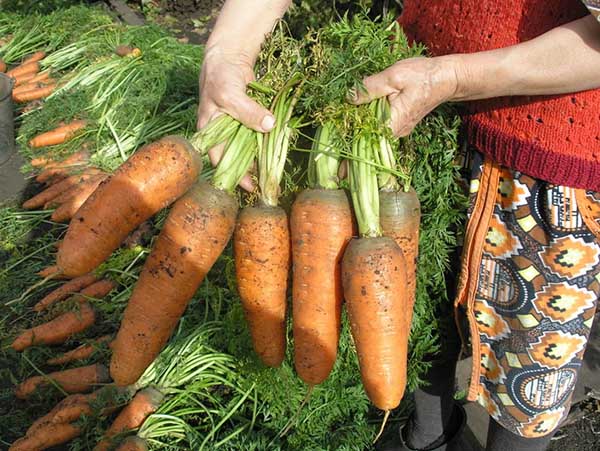
Content
How to care for carrots outdoors: basic rules for growing
Let's take a look at all the main (key) agronomic techniques for carrot care.
Watering and humidity
Carrots are very moisture demanding.
When improper watering carrots grow curve (branched), hairy (hairy)and also can crack.
By the way! The site has detailed material about when and how to water carrots.
- Until the emergence of shoots and the formation of real leaves, carrots do not need to be watered: they have enough moisture that was obtained during sowing. In addition, carrots are planted early enough when the soil is still cool and moist.
However, if the weather is warm and dry, watering is a must.
- Very important water the carrots regularly at the beginning of growth (after germination)when the plant still has a weak root system (at this time it extracts water rather weakly from the soil and spends a lot on evaporation).
- When the plant has a sufficiently developed root system, it will no longer need frequent watering, because will be able to independently extract the necessary moisture at a depth.
- You need to stop watering the carrots when about 2-3 weeks remain before harvesting the carrots, so as not to cause cracking of root crops when they are overripe.
Advice! However, it is advisable to make the last watering abundant enough to reduce the accumulation of nitrates in root crops.
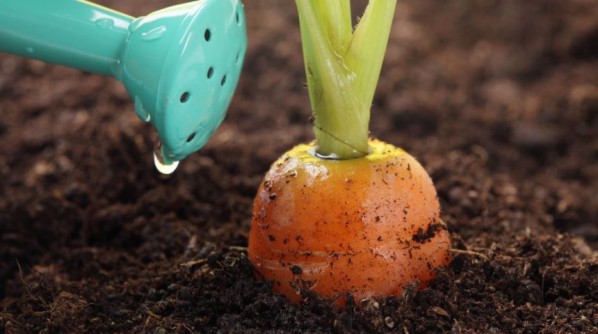
As for how to water carrots, then, as a rule, this is done in the most usual way - under the root or along the grooves... However, it is believed that carrots are very responds well to small-drop irrigation.
What is drip irrigation? It is almost a fog that hangs in the air and slowly settles down.
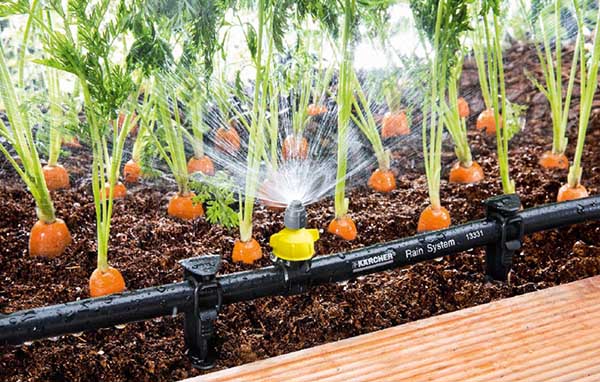
Note! Detailed information about how to properly water carrot bedsyou can get by reading this article.
Top dressing
All nutrients (fertilizers) should be applied before directly sowing carrot seeds in the ground (i.e. more during the preparation of the beds for carrots). The fact is that the introduction of fertilizers (especially nitrogen) during the growing season can only provoke an increased accumulation of nitrates in the root cropx and also call cracking and deformation of root crops (may become horned).
However, if you planted carrots in unfertilized soil, then you can feed (with liquid fertilizers, i.e. solutions or infusions):
- at the beginning of the growing season (after the appearance of real leaves) - nitrogen fertilizer (green fertilizer, infusion of mullein or bird droppings, urea or ammonium nitrate);
- during the period of growth of root crops (after the formation of 3-5 leaves and the last thinning) - potassium fertilizer (wood ash or potassium magnesium), you should also give phosphorus - superphosphate infusion.
Advice! Magnesium fertilizers can increase the carotene content in fruits.
What fertilizers contain a lot of magnesium?
- Magnesium sulfate (magnesium + sulfur).
- Kalimagnesia (potassium + magnesium)
Mulching
If you want to water less often, then, as an option, you can try mulching aisles carrots (when it has already risen, it will grow a little and you will carry out the last thinning) sawdust, straw or hay, cut grass... Then the moisture will stay better and longer in the soil. Thanks to the mulch, it will also less weeds and no need to weed the beds.
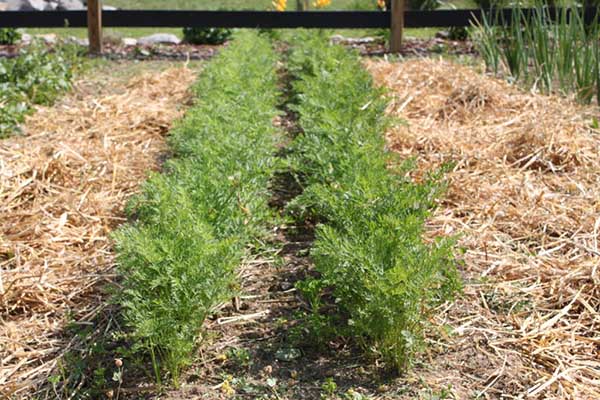
Loosening and weeding
If you do not want to mulch, then you will have to loosen and weed from weeds more often.
Carrots are very responsive to loosening the soil, because thanks to this procedure oxygen enters (penetrates) better to the roots, which is necessary for the development of a good root crop. However, this must be done carefully, in no way affecting the plants themselves.
So, after each watering and rain, when the water is absorbed (after 1-2 hours), do not forget to loosen the row spacing to a shallow depth (about 3-4 cm).
By the way! Thanks to loosening, you can also partly get rid of carrot flywhich lays eggs next to root vegetables.
It is also very important to carefully weed the bedssaving them weeds.
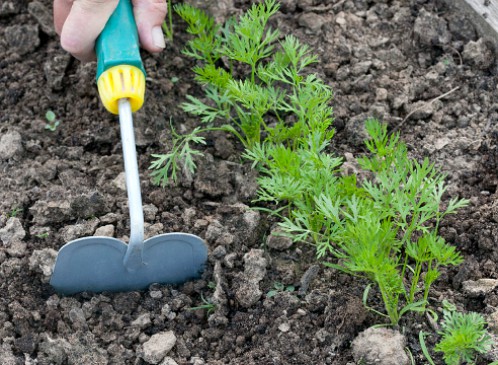
Thinning
Thinning should be done with strong thickening, i.e. dense planting.
By the way! If you initially sowed the seeds at a sufficient distance of 3-5 cm, then thinning is not required!
At the same time, one should not wait until the root crops begin to actively increase in size (the first thinning can be done after the formation of 2-3 leaves, the second - 3-5 leaves). Otherwise, when thinning, you can simply damage nearby roots, which will lead to their deformations and loss of quality appearance.
By the way! More details about the timing and methods of thinning carrots you'll find in this article.
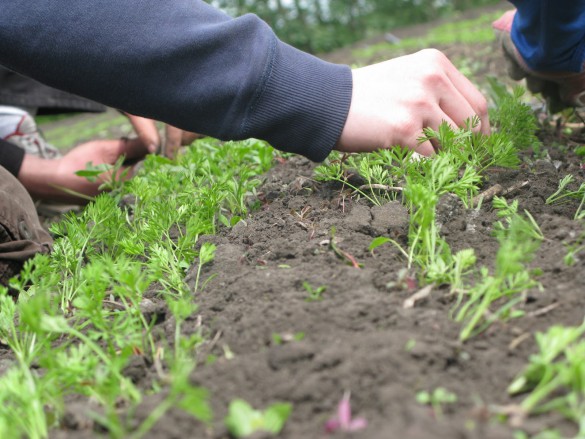
The main pest of carrots and other growing problems
The most common and dangerous pest of carrots is carrot fly... An adult pest lays its eggs in moist soil next to the emerging root crop. Of these, larvae subsequently appear, gnawing passages in carrots. They fill them with the products of their vital activity, thereby making the root crops unusable.
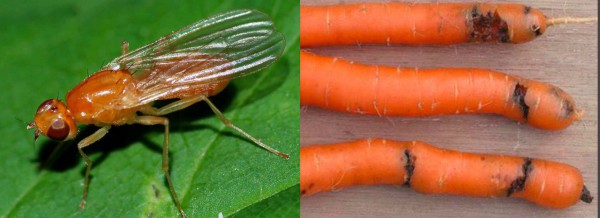
In order to scare off the carrot fly from carrot plantings, joint plantings are often made with onions (but, as practice shows, this is a very ineffective way of protection).
Important! ABOUT Tom, how to effectively deal with carrot fly in the garden,read here.
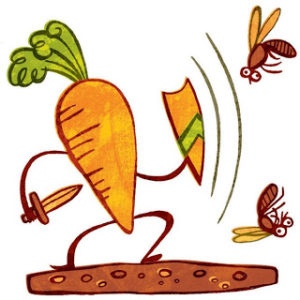
Of course, carrots also have other enemies, eg, carrot beetle (as a rule, the same control measures are used against it as with the carrot fly). Also plants may be affected by diseases such as phomosis, bacteriosis, various rot (white and black - mainly during storage). But compared to the attack on the carrot fly beds, this happens relatively infrequently, even rarely.
Why do carrots grow gnarled, hairy and cracked?
Due to non-compliance with the rules of cultivation (especially with regard to watering), root crops very often undergo deformations and become gnarled and hornyand can also literally Overgrown with hairand crack. About, why it happens and how to avoid it, you can find out from the related articles (from the links above).

When to harvest carrots and how to store them
It is recommended to harvest root crops in dry weather. Moreover, it is better to do this at a low temperature: this way, nutrients will be well preserved in root crops, and they will be stored noticeably longer.
Note! The site already has an article abouthow to tell when to dig up and store carrots.

Advice! As for the methods of storing fresh carrots for a long time, the site also has material about how to properly store the harvested carrot crop at home.
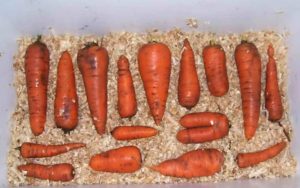
Thus, in order to get a good harvest of carrots, you will need to properly care for the seedlings, as well as dig out the harvest from the garden in time. Well, what do you want? Good luck!

